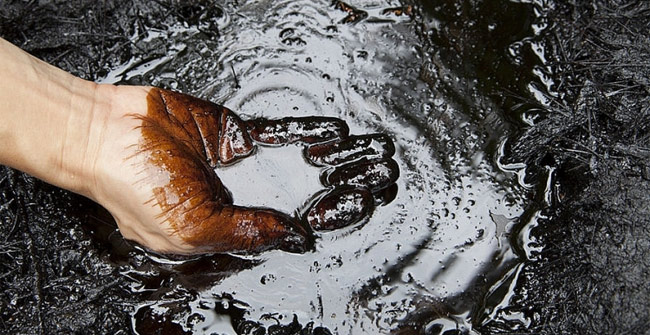What is petroleum?
Nearly everyone has heard or read about oil, the fuel produced by humans in the modern world. But not everyone knows the basic knowledge of this kind of material called 'black gold' .

Pure oil.
Structure of oil
Petroleum is a useful mineral, exists in the form of viscous, greasy and often black (but also transparent or other colors). In terms of chemistry, oil is a mixture of hydrocarbons with sulfur, nitrogen and other compounds. The smell of oil may also vary, depending on the content of aromatic hydrocarbons and sulfur compounds in its composition.
Hydrocarbons present in oil are chemical compounds including carbon (C) and hydrogen (H) atoms. In general, the hydrocarbon formula is CxHy. The simplest hydrocarbon is methane, which has one carbon atom and four hydrogen atoms, its formula is CH4. Methane is a mild hydrocarbon, always present in oil.
Depending on the quantitative ratio of the different hydrocarbons that make up the oil, the properties of the oil are also different. Oil can be transparent and flowing as easily as water, but it can also be black, dense and flexible like tar (asphalt).
From the point of view of chemistry, normal oil (traditional) has the following basic elements: Carbon - 84%; Hydrogen - 14%; Sulfur - 1-3% (in the form of sulfides, disulphides, hydrogen sulphide or pure sulfur); Nitrogen - less than 1%; Oxygen - less than 1%; Metal - less than 1% (including iron, nickel, vanadium, copper, chromium, cobalt, molybdenum .); Salt - less than 1% (calcium chloride, magnesium chloride, sodium chloride .).
Concurrent oil and gas are located in the depths of tens of meters to 5-6 km and at a depth of 6 km or less, only gas, at a depth of 1 km or more - only oil. Most of the hydrocarbon-rich layers are located at a depth of 1 to 6 km, where oil and gas exist in different combinations.
Oils often accumulate in rock layers called seams that collect and store materials of a mobile nature (such as oil, gas, water). Simply, the reservoir can be considered a very firm and dense sponge, absorbing and containing oil.
Origin of oil
The formation of oil is a very long process, going through several stages and taking a period of time according to some estimates of 50-350 million years.
Proven and recognized most commonly so far is the theory of organic origin of oil, also known as biological theory. According to this theory, oil is formed from the bodies of microorganisms that once existed tens or even hundreds of millions of years ago in large water basins (especially in shallow waters). When they die, the bodies of these microorganisms create layers of material with high levels of organic matter at the bottom. This layer follows another layer, gradually sinking deeper and deeper (this process takes millions of years); The underlying layers are affected by the increasing pressure of the upper layers, accompanied by an increase in temperature. Because these physico-biochemical processes occur in anaerobic (non-oxygen) environment, the organic matter is converted into hydrocarbons.
Some hydrocarbons are formed in the gaseous state (lightest), others are in a liquid state (heavier) and some are solid (heaviest, like coal). Thus, the mobile mixture of hydrocarbons in the gas and liquid states, under the action of high pressure, gradually moves by permeating through the layers of rock toward the lower pressure areas (usually upwards). on). The motion continues until hydricarbon gas or liquid encounters a thick layer of impermeable rock layer on its way and is forced to stop. This is the trap, formed as a reservoir above which is covered by an impenetrable layer of rock. In this trap, a mixture of hydrocarbons gradually accumulates, forming what we often call oil fields.
Because the physical density of oil is often much smaller than the density of water (water is always present with oil as a proof of sea origin of oil), oil always moves up and accumulates above. water surface. If there is gas, the gas will be at the top, above the oil.
In some areas, hydrocarbons in the form of oil and gas do not encounter a trap on the way to the earth's surface. When escaping on the ground, under the impact of many physical and chemical factors, their structure is destroyed and they turn to exist in the form of other materials.
- The largest floating device in the world
- Japan drill to prepare to exploit gas in the seabed
- Launched explosion proof composite gas tank
- Apply computer simulation techniques to find oil
- Floating ships produce liquefied gas longer than the Eiffel Tower
- Amazing applications of oil
- Find oil from the air
- Asia in the race to find green energy
- 7 unexpected applications of oil
- Fish meat made from ... grass
- 10 most modern public transport facilities in the world
- Ho Chi Minh City: Manufacturing alternative energy batteries for petroleum
 'Fine laughs' - Scary and painful torture in ancient times
'Fine laughs' - Scary and painful torture in ancient times The sequence of numbers 142857 of the Egyptian pyramids is known as the strangest number in the world - Why?
The sequence of numbers 142857 of the Egyptian pyramids is known as the strangest number in the world - Why? History of the iron
History of the iron What is alum?
What is alum?